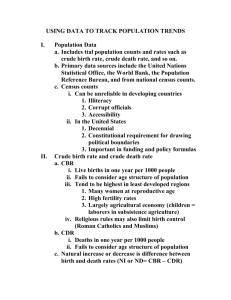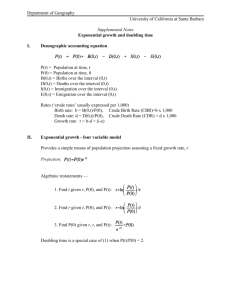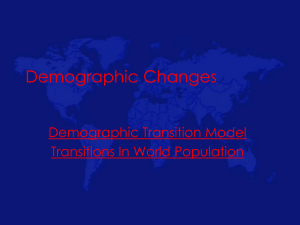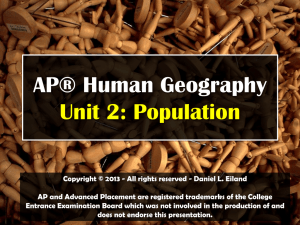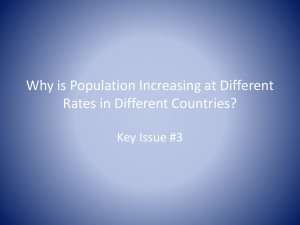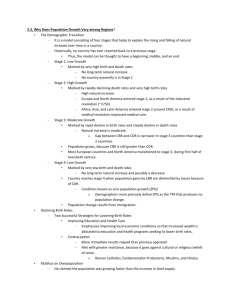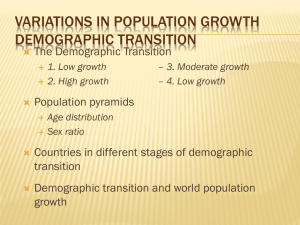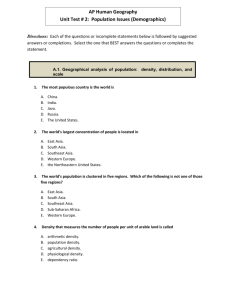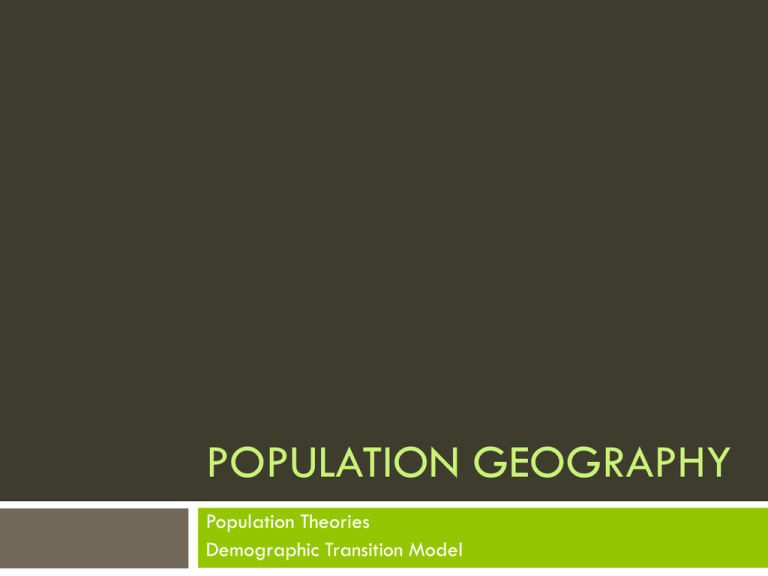
POPULATION GEOGRAPHY
Population Theories
Demographic Transition Model
Population Theories
BUT REMEMBER…
The agricultural revolution allowed for cities and
faster population growth rates (10,000-12,000
years ago).
•
The Industrial Revolution allowed for even faster
growth rates (starting in the 1700s).
•
•
Earth has experienced a
POPULATION EXPLOSION in the last 2-3 centuries.
Thomas Malthus
Economist and geographer
Essay on the Principle of Population
(1798)
Claims
based on:
1.)
People need food to survive
2.) People have a natural desire to reproduce
Food
production increases arithmetically
(linear growth) while population grows
geometrically (exponential growth).
Thomas Malthus
Argued that human population growth would
eventually outpace people’s ability to produce food.
This little problem would lead to war, starvation, and
disease, or “negative checks” on the population.
Advocated for “positive checks” such as birth control and
celibacy.
HAS
THIS
HAPPENED?
Arguments against Malthusian
perspective
Malthus did not fully account for the ability to
people to increase food production dramatically
with new agricultural technologies.
Genetic
engineering
Improved fertilization techniques
Modern farm equipment
Arguments against Malthusian
perspective (continued)
Did not foresee population growth would slow down
over time.
Contraception
Changing
role of women
Individual choice of not having children
Did not recognize famine is usually not related to
lack of food, but to the unequal distribution of food.
Neo-Malthusians
Apply some ideas in the
Malthusian theory.
Human population growth must
reach a “sustainable” level
within carrying capacity.
Regional rather than global.
Paul Ehrlich
The Population Bomb (1968)
Neo-
Malthusian ecologist
Made
the argument about the
ability of the earth to
sustainably provide resources
for an exponentially growing
population.
Mass starvations
Societal uprisings
Raised
the general awareness
of population and
environmental issues and
influenced public policy.
The battle to feed all of
humanity is over. In the 1970s
hundreds of millions of people
will starve to death in spite of
any crash programs embarked
upon now. At this late date
nothing can prevent a
substantial increase in the world
death rate...
Other theories…
Karl Marx
Population
growth rates are not the problem but the
unequal distribution of resources and wages would
eventually lead to class warfare.
Ester Boserup
Believed
that the overpopulation problem could be
solved by increasing the number of subsistence farmers.
Population Pyramids
AGE-SEX STRUCTURES
Population Cohort
A group of people that all have something in
common and are usually grouped together for
statistical purposes.
In population pyramids, each cohort is split between
men and women.
Population Pyramids
A model used in population geography to show the
age and sex distribution of a particular population.
Shape matters…
Wide-base= more young people
Top-heavy= more old people
Tells you about the current population and can give
you information about the FUTURE!
Predicting Populations
Demographic Transition Model
Several models have been developed to explain
changes in population over time and to relate
various social, economic, and environmental
factors to population growth.
Demographic Transition Model
Explains changes in the natural increase rate as a
function of economic development.
Demographic Transition Model
Three measurements used in the DMT
Crude birth rate (CBR)
Crude death rate (CDR)
Natural increase rate (NIR)
Stages of “Transition”
Stage 1, Low Growth
Stage 2, High Growth
Stage 3, Moderate Growth
Stage 4, Low Growth
Stage 1, Low Growth
(High Stationary Stage)
High CBR and CDR.
Natural increase rate essentially zero.
During this stage, most people depend on hunting
and gathering for food.
Subsistence farming country without an
industrialized economy.
Stage 2, High Growth
(Expanding Stage)
Crude death rate suddenly plummets, while crude
birth rate roughly remains the same.
Children
are needed on farms (high CBR).
New health care systems arrive (medicine) and
industrialization has begun (lowered CDR).
Therefore, the natural
increase rate is also
very high, and
population grows
rapidly.
Stage 3, Moderate Growth
(Expanding Stage)
Crude birth rate begins to drop sharply.
The population continues to grow because the CBR is still
greater than the CDR, but the increase is more modest.
People choose to have fewer children.
Population more likely to live in cities and to work in offices,
shops, etc. rather than farms.
Children will live longer because of new health care
technology available.
Women have more options in newly industrialized economy.
Stage 3, Moderate Growth
(Expanding Stage)
Crude birth rate begins to drop sharply.
The population continues to grow because the CBR is still
greater than the CDR, but the increase is more modest.
People choose to have fewer children.
Population more likely to live in cities and to work in offices,
shops, etc. rather than farms.
Children will live longer because of new health care
technology available.
Women have more options in newly industrialized economy.
Stage 4, Low Growth
(Low Stationary Stage)
Crude birth rate declines to the point where it
equals the crude death rate
Zero
population growth or very low NIR.
Modern-society stage.
Stage 5 (Proposed)
Would show a
continuing
decline in the
CBR
Seen
in moredeveloped
countries such
as France and
Germany.
Is the
Demographic Transition Model
UNIVERSALLY
Applicable?????
Arguments against DTM
Too simplistic
Eurocentric model?
Factor such as culture, religion, geopolitics,
migration, and the structure of the global economic
system itself may prevent many of today’s less
developed countries from ever taking the path
described.
More
people today.
Economies transitioning way faster now.
Regional differences


